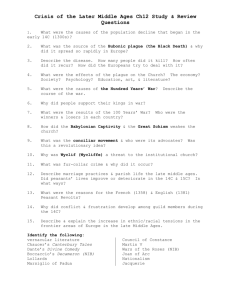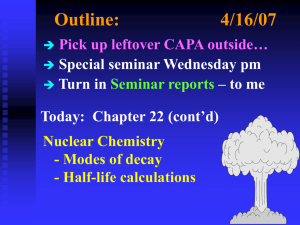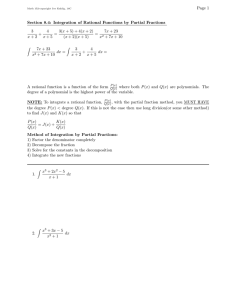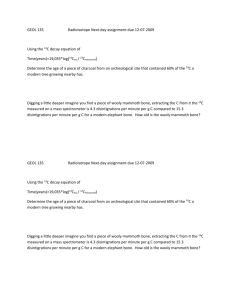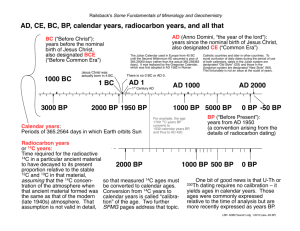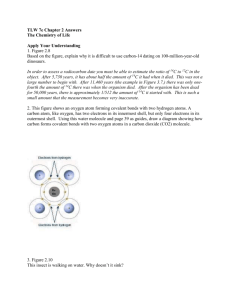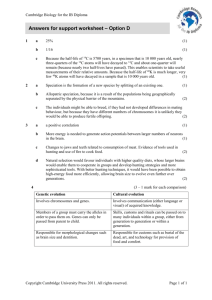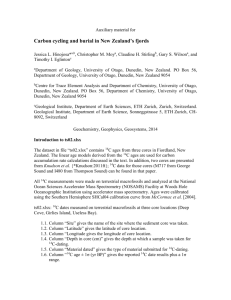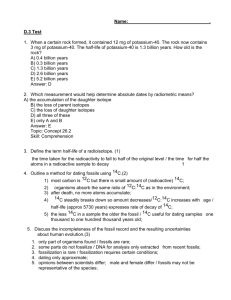N C Experiment 5 – Radiocarbon Dating
advertisement
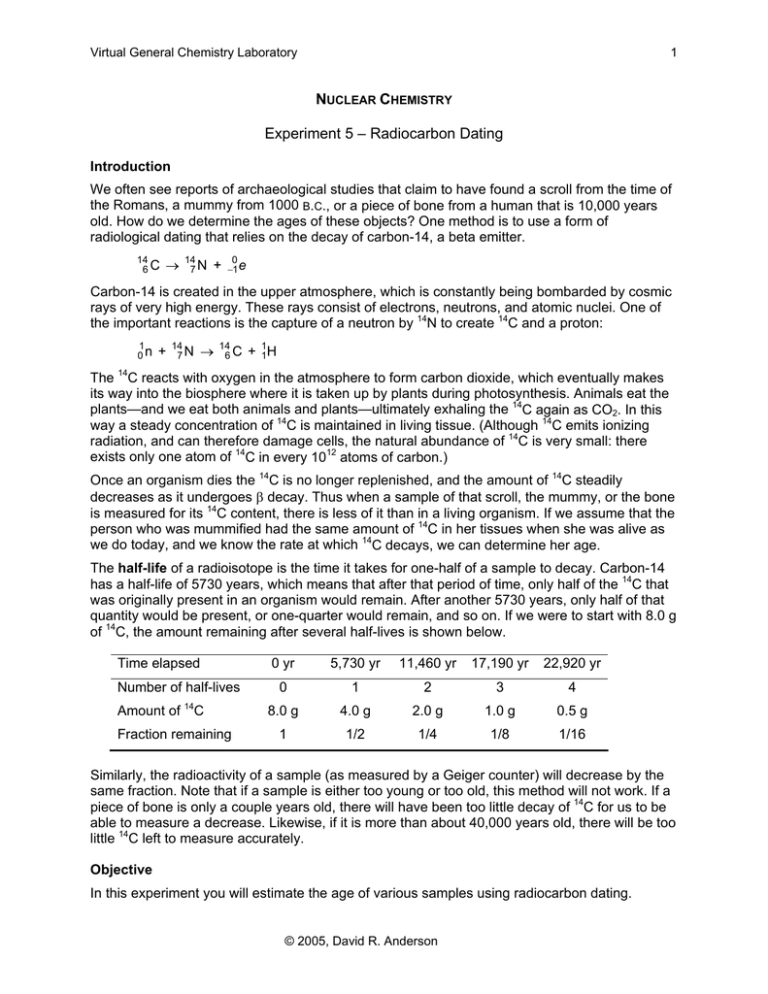
Virtual General Chemistry Laboratory 1 NUCLEAR CHEMISTRY Experiment 5 – Radiocarbon Dating Introduction We often see reports of archaeological studies that claim to have found a scroll from the time of the Romans, a mummy from 1000 B.C., or a piece of bone from a human that is 10,000 years old. How do we determine the ages of these objects? One method is to use a form of radiological dating that relies on the decay of carbon-14, a beta emitter. 14 6C → 14 7N + 0 −1 e Carbon-14 is created in the upper atmosphere, which is constantly being bombarded by cosmic rays of very high energy. These rays consist of electrons, neutrons, and atomic nuclei. One of the important reactions is the capture of a neutron by 14N to create 14C and a proton: 1 0n + 14 7N → 14 6C + 11H The 14C reacts with oxygen in the atmosphere to form carbon dioxide, which eventually makes its way into the biosphere where it is taken up by plants during photosynthesis. Animals eat the plants—and we eat both animals and plants—ultimately exhaling the 14C again as CO2. In this way a steady concentration of 14C is maintained in living tissue. (Although 14C emits ionizing radiation, and can therefore damage cells, the natural abundance of 14C is very small: there exists only one atom of 14C in every 1012 atoms of carbon.) Once an organism dies the 14C is no longer replenished, and the amount of 14C steadily decreases as it undergoes β decay. Thus when a sample of that scroll, the mummy, or the bone is measured for its 14C content, there is less of it than in a living organism. If we assume that the person who was mummified had the same amount of 14C in her tissues when she was alive as we do today, and we know the rate at which 14C decays, we can determine her age. The half-life of a radioisotope is the time it takes for one-half of a sample to decay. Carbon-14 has a half-life of 5730 years, which means that after that period of time, only half of the 14C that was originally present in an organism would remain. After another 5730 years, only half of that quantity would be present, or one-quarter would remain, and so on. If we were to start with 8.0 g of 14C, the amount remaining after several half-lives is shown below. Time elapsed Number of half-lives Amount of 14C Fraction remaining 0 yr 5,730 yr 11,460 yr 17,190 yr 22,920 yr 0 1 2 3 4 8.0 g 4.0 g 2.0 g 1.0 g 0.5 g 1 1/2 1/4 1/8 1/16 Similarly, the radioactivity of a sample (as measured by a Geiger counter) will decrease by the same fraction. Note that if a sample is either too young or too old, this method will not work. If a piece of bone is only a couple years old, there will have been too little decay of 14C for us to be able to measure a decrease. Likewise, if it is more than about 40,000 years old, there will be too little 14C left to measure accurately. Objective In this experiment you will estimate the age of various samples using radiocarbon dating. © 2005, David R. Anderson Virtual General Chemistry Laboratory 2 Procedure 1. Open the worksheet for Experiment 5. (You should fill in the data within Excel, so that you can use the interactive graph, then print out the results afterward.) 2. Click on the apparatus to start the lab. (If you are using Internet Explorer, you will have to click once to activate the control, then click again to start the lab.) The experimental setup includes a number of samples of 14C isolated from objects discovered in archaeological excavations, and the apparatus to measure the radioactivity. On the right is a Geiger counter that will measure radiation in counts per second. On the left is a holder for the sample. 3. Click on the drop-down list of samples and choose one. Drag the sample into the sample holder. (There is information on each sample in the box that pops up. After reading it, you can close the box, or it will close on its own when you click on something else.) 4. Click on the Geiger counter switch to turn it on. Record the activity of the sample in counts/sec. (The needle on the gauge may move around a bit. You should try to get an average reading. Note that the scale on the gauge is not linear.) 5. Click the switch again to turn it off. 6. Repeat steps 3-5 for the other samples. 7. For one of the present-day materials, type its activity in the “Initial Activity” cell and hit Enter. This will generate a decay curve for 14C based on that starting activity. 8. For each of the archaeological objects made of that material, estimate its age using its activity and the 14C decay curve. 9. Repeat steps 7-8 for the other materials. © 2005, David R. Anderson
